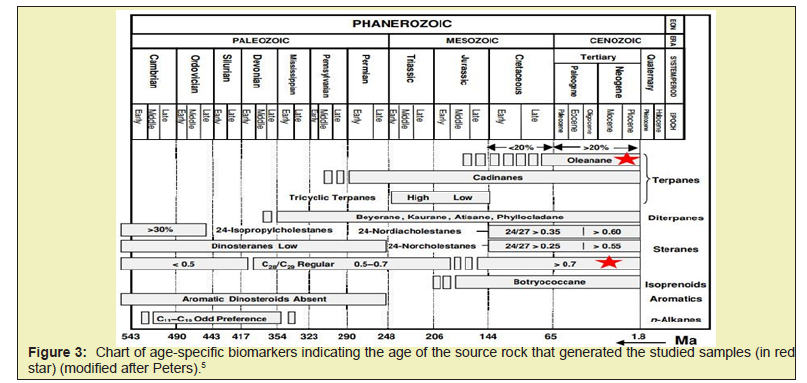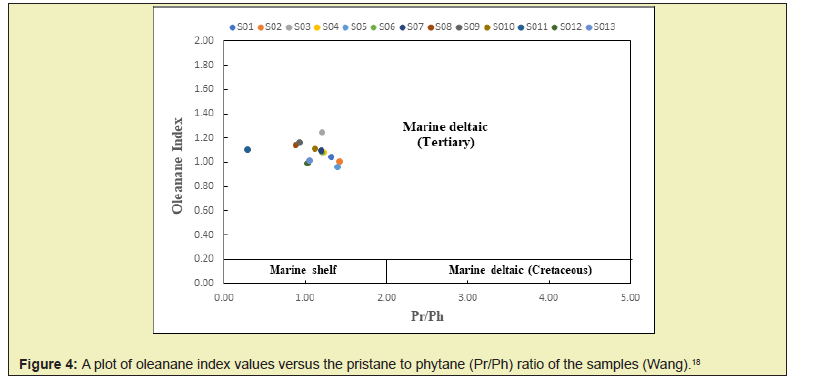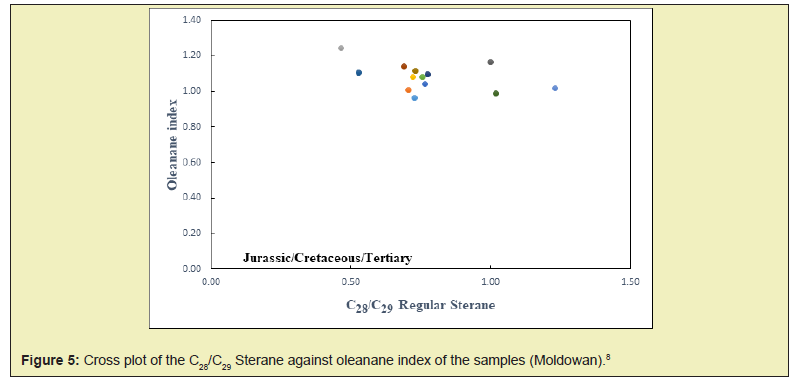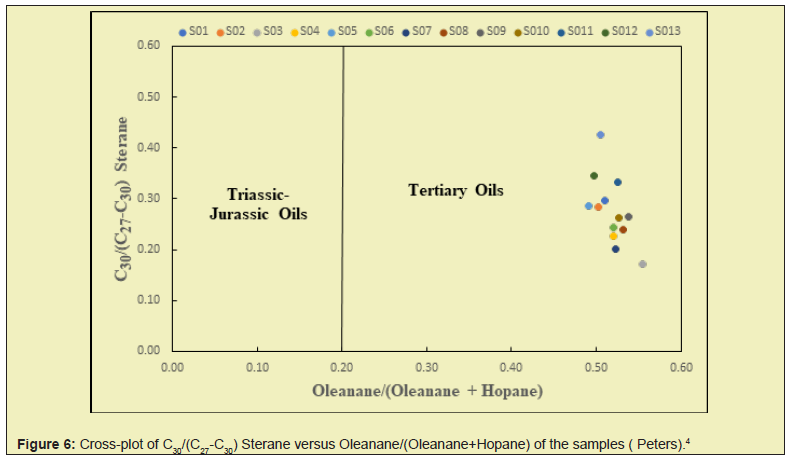The Niger Delta Basin is a prolific petroleum province and is currently the only basin in which commercial petroleum production strives in Nigeria. The Niger Delta Basin has received a lot of research attention but with fewer studies regarding the reconstruction of the age of source rocks from their crude oils using biomarkers. The study aimed at reconstructing the age of the Niger Delta source rocks from crude oils samples from the Basin. The age determination of the sample set was attempted by looking at individual age-specific biomarkers that suggested a source age as well as looking at them together to have a clearer indication of the likely source age. Thirteen (13) crude oil samples from the “Y” Field of the Niger Delta Basin were subjected to Gas Chromatography-Mass Spectrometer analysis. The biomarkers used in this study were; oleanane index (OI), C28/C29 ratio, C30/(C27-C30) ratio, and Pr/Ph (pristane/phytane) ratio, with corresponding mean values of 1.08, 0.76, 0.28, and 1.12 respectively. The biomarker data based on some age-specific biomarkers, both individually and especially when used together, suggests a Tertiary age for the source rock that generated the crude oils. These results are based on the occurrences of oleanane, Pr/Ph ratios, and the high C28/C29 ratios, all indicating Tertiary age source rock.
Keywords: Biomarker, Crude oil, Niger delta, Tertiary, Source rock
Biomarkers are compounds, chiefly hydrocarbons which are detected in oils or extracts from rocks as current sediment and soil extracts. Basically, biomarkers comprise composite organic molecules whose chemical structures mostly remain unaltered during diagenesis and oil generation processes.1 This frequently appropriates them to be tracked back to the indigenous molecules in formerly living organisms. They are recognized as molecular fossils due to the aforementioned reasons. Structurally, they are similar to and are alteration products of diagenetic processes of particular natural products.1 According to2 biomarkers can be used to reconstruct the age of source rocks. This is possible because certain biomarkers appear not till their parent organism has developed, hence the availability of these compounds can be used as an age specific marker. Age-diagnostic biomarkers are crucial, in that, they aid in identifying the source of crude oils that may have journeyed several kilometers from its source rock.2 Even when samples of the source rock are unavailable, biomarkers in oil that were inherited from the source rock can be used for indirect correlation because they provide information on its character, including the type of organic matter, lithology, redox conditions during deposition, and age.3
Peters4 indicated that sterane biomarkers are gotten from steroids, which are vital components of eukaryotic cell membranes. They added that steroids have been gathered by several organisms from Precambrian to recent times. The study of Peters4 indicated that C28 and C29 steranes are regular components from green algae while C27 steranes are abundant in red algae in marine environment. The works of Moldowan5 and Grantham and Wakefield6 pointed out that C28/C29 steranes differ with the geological age of source rocks of marine origin, hence the regular 28/C29 sterane ratio can be used to evaluate the age of oils generated from marine source rocks. The differences in the ratio of C28/C29 are explained to be the result of variegation of sterane-producing organisms in the Jurassic and Cretaceous periods, especially those that bring forth C28 compounds over geological time.4 Again, Peters4 cautioned the use of this ratio without other consideration due to certain exclusions, such as land plant sources that have a high concentration of C29 steranes. They added that the C28/C29 regular steranes ratio is best fitted to differentiating Paleozoic from Tertiary sources, which applies only to marine organic facies.
Oleananes probably gotten from pentacyclic triterpenes in angiosperms are the earliest angiosperm fossil found in Early Cretaceous rocks.5 Therefore, the availability of oleanane denotes organic matter sourced from land plants, precisely angiosperms, and of mid-Cretaceous age or younger.7 Moldowan8 indicated that angiosperms increased and spread rapidly in the Late Cretaceous and became dominate the terrestrial biota by the close of the Cretaceous. Thus, oleanane is present, though in some cases in reduced quantities, in a majority of crude oil samples from the Cretaceous reservoirs in the world.
A higher concentration of oleanane strengthens an interpretation of a Tertiary source; the source rock most likely has Tertiary age if oleanane is greater than 20%.5 At low concentrations, other compounds unrelated to oleanane can be mistakenly identified as oleanane. The presence of oleanane does not rule out a pre-mid-Cretaceous source because oils generated from older strata could have migrated through post-mid-Cretaceous strata. Conversely, the absence of oleanane does not rule out a post-mid-Cretaceous source. Highly mature material or sources dominated by marine organic matter will have low concentrations of oleanane.
The Cenozoic Niger Delta Figure 1 overlies an area that is over 256,000km2 and it is situated in the Gulf of Guinea, between longitude 50E to 80E and latitudes 40N to 60N.9 The Niger Delta Basin is a prolific petroleum province and is currently the only basin in which commercial petroleum production strives in Nigeria. Based on the petroleum system, the Niger Delta has an active petroleum system, which is Tertiary in age confined to the Akata–Agbada sediment sequence.10 The Niger Delta Basin fill is the youngest of the three large sediment bodies that filled the aulacogen formed after the separation of the African and South American plates. It was initially built out over a transgressive Paleocene pro-delta as river-dominated lobes which later coalesced and became high-energy, wave-dominated, and tide-influenced depo-belts.11 The delta grossly consists of three subsurface lithostratigraphic units Figure 2 namely, the marine Akata shales, the paralic Agbada formation, and the continental Benin formation. The Niger Delta is a hydrocarbon province with ultimate recovery presently estimated at 40 billion barrels of oil, which is about 70% of the overall hydrocarbon reserves of sub-Saharan Africa.12 The gas reserves in the Niger Delta are conservatively estimated at over 40 trillion cubic feet.13 The hydrocarbon was sourced from marine shales with land plant materials giving rise to mainly Types III and II organic matter within an oil window that varied in depth from 9,000 to 14,000ft. The reservoirs are mainly shoreface, beach, channel sands bearing low sulfur/nickel, light waxy, nondegraded oils. light crude-bearing deeper reservoirs have also been substantiated in some inland blocks.14-16
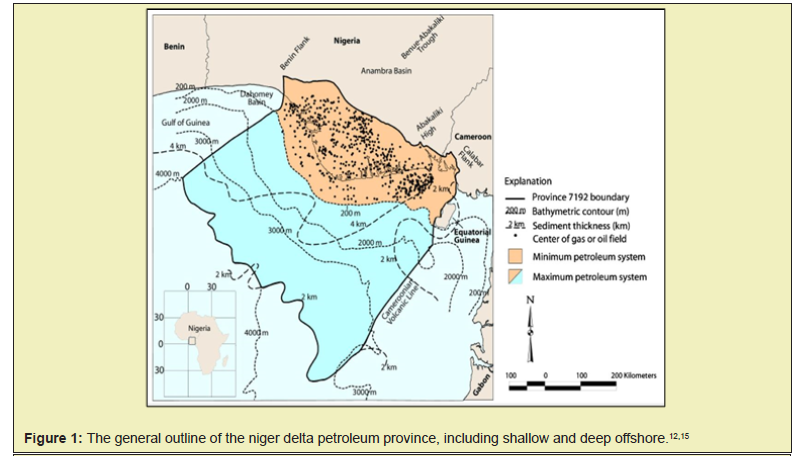
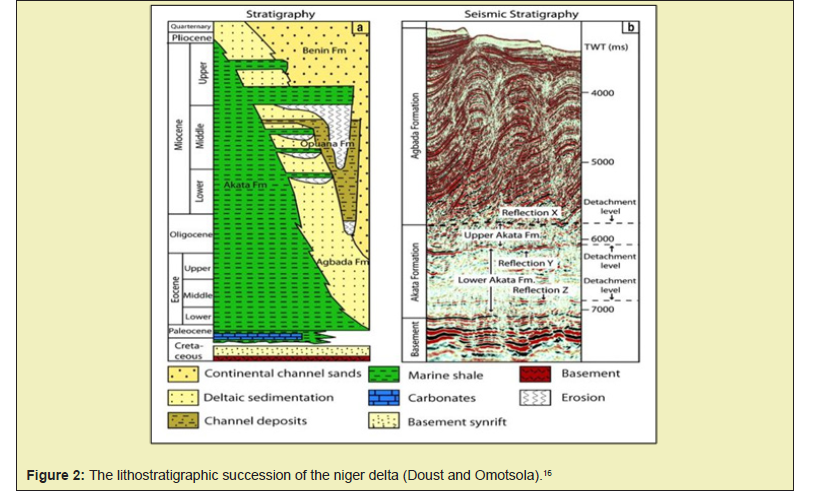
Thirteen (13) crude oil samples from the “Y” Field of the Niger Delta Basin were used for this study. The samples were deasphaltened and the maltene fraction fractionated into aromatics, saturates, and polar fractions. The saturates and aromatics were further subjected to Gas chromatography-mass spectrometry analysis. The biomarker chromatogram accession was controlled by the chemstation software in selected ion mode (SIM). The n-alkanes and isoprenoids for the analysed samples were distinguished using m/z 85, the sterane biomarkers were detected on m/z 218 and that of the triterpane and hopane were identified on m/z 191. The biomarker chromatograms were compared to that of Peters17 for the identification of their peaks.
As an angiosperm (flowering plant) indicator, Oleanane, a biomarker indicative of higher terrigenous plants, has been suggested.19 The oleanane to C30 hopane ratio (considered to be the oleanane index) provided details on the depositional environment and the age of source rock.20 An Oleanane index value greater than 0.2 suggests that the oil generating source rock is of Tertiary age.21 Oleanane index values lower than 0.2, on the other hand, are typical of Cretaceous source rocks.21 The oleanane index for the analysed samples varies from 0.96 - 1.24, having a mean value of 1.08 Table 1. The oleanane index of greater than 0.2 (> 0.2) for the studied samples (Table 1) indicates the source rock that generated the crude oils is Tertiary in age. The cross-plot shown in Figure 4, proposed by Wang18 supports this and it is consistent with the age suggested by the chart in Figure 3 for the studied samples. Peters4 indicated the plot of C30/(C27–C30) steranes ratios against oleanane/ (oleanane+hopane) Figure 6 gives a better assessment of the age of source rocks from crude oils. The cross-plot confirms a tertiary age for the oil generating source rock. Grantham and Wakefield6 pointed out that the C28/C29 sterane ratio increases steadily with decreasing age of oil generating source rocks. High ratios of CC28/C29 sterane have been used to distinguish the age of oils and source rocks.18,22 This course is as a result of the rise in the concentration of C28 over C29 with time owing to the egression of coccolithosperes and dinoflagellates at the close of the Paleozoic and the emergence of diatoms and silicoflagellates in the Late Cretaceous.8 Again, Huang and Meinschein23 indicated that C28/C29 ratio is best suited for marine source rocks or oils generated by marine source rocks. The ratio of C28/C29 of the analysed samples were high with an average value of 0.76 Table 1, suggesting a Tertiary age for the source rock that generated the studied samples. This is corroborated by the chart in Figure 3. The plot of oleanane index and the C28/C29 sterane ratio for the samples Figure 3 further suggests a tertiary age for the source rock that generated the examined oils. This is supported by the cross plot in Figure 4.
Age-specific biomarkers have been used to reconstruct the geologic age of the source rock that generated the crude oil samples obtained from the Niger Delta Basin. The oleanane index for the analysed samples varies from 0.96 -1.24, having a mean value of 1.08. The C28/C29 ratios of the analysed samples are high with an average value of 0.76. The high abundance of oleanane as seen in the oleanane index value coupled with the high CC28/C29 ratio suggests a Tertiary age for the hydrocarbon source rock that generated the studied Niger delta crude oils. Future studies should use isotope geochemistry to corroborate the findings from the biomarkers
The African Centre of Excellence, Centre for Oilfield Chemicals Research, University of Port Harcourt, Port Harcourt, Nigeria is well appreciated. Many thanks to Louis Max Petroleum Company for providing the data set used in this study.
None.
Author Declares that there is conflicts of interest.
- 1. Weatherford Limited. Using oil biomarkers in petroleum exploration. 2018;p.8.
- 2. Peters KE, Moldowan JM. The Biomarker Guide: Interpreting Molecular Fossils in Petroleum and Ancient Sediments. Patience Hall, Inc. New Jersey. USA, 1993.
- 3. Peters KE, Walters CC, Moldowan JM. Biomarkers. Assessment of Petroleum Source-Rock Age and Depositional Environment. In: Sorkhabi R (eds) Encyclopedia of Petroleum Geoscience. Encyclopedia of Earth Sciences Series. Springer, Cham. 2017.
- 4. Peters KE, Walters CC, Moldowan JM. The Biomarker Guide: Biomarkers and Isotopes in Petroleum Systems and Earth History, Cambridge University Press, Second Edition. UK, 2005.
- 5. Moldowan JM, Seifert WK, Gallegos EJ. Relationship between petroleum composition and depositional environment of petroleum source rocks. American Association of Petroleum Geologists Bulletin. 1985;69:1255-1268.
- 6. Grantham P, Wakefield L. Variations in the sterane carbon number distributions of marine source rock derived crude oils through geological time. Organic Geochemistry. 1988;12:61-73.
- 7. Philp RP, Gilbert T. Biomarker distributions in Australian oils predominantly derived from terrigenous source material. Organic Geochemistry. 1986;10:73-84.
- 8. Moldowan JM, Dahl J, Huizinga BJ. The molecular fossil record of oleanane and its relation to angiosperms. Science.1994;265:768–771.
- 9. Opafunson ZO. 3D Formation Evolution of an oil field in the Niger Delta Area of Nigeria using Schlumberger Petrol Workflow Tool. Journal of Engineering and Applied Science. 2007;2(11):651-1660.
- 10. Abrakasa S, Ukaegbu V, Onojake M. The source kitchen of the Niger Delta oils: case study on Nembe Creek E1.0 and the Kolo Creek E2.0 reservoirs. J Petrol Explor Prod Techno. 2016,6:331–341.
- 11. Nwajide CS. Geology of Nigeria’s Sedimentary Basins. CSS Bookshops Ltd. 2013, Lagos, Nigeria
- 12. Adegoke OS, Oyebamiji AS, Edet JJ, et al. Cenozoic Foraminifera and Calcareous Nannofossil Biostratigraphy of the Niger Delta. Elsevier, Amsterdam, Netherlands. 2017.
- 13. Akinlua A. The role of analytical chemistry in Niger Delta petroleum exploration: A review. Analytica Chimica Acta. 2012;730:24–32.
- 14. Mosunmolu Limited. Petroleum Systems Modeling of the Egbaoma Field, OML 38. An Unpublished Report for Platform Petroleum Ltd. 2014
- 15. Takyi B, Abrakasa S, Udom JG, et al. Reservoir Compartmentalization Studies of the “X” Field of the Niger Delta, Nigeria, University of Mines and Technology (UMaT) 6th Biennial International Mining and Minerals Conference, Innovation in Mining and Mineral Processing; Expanding the Frontiers of Mining Technology, 2020.
- 16. Doust H, Omatsola E. Niger-Delta. In: Edwards JD, Santogrossi PA (eds) Divergent/passive margins basins: AAPG Memoir, 1990;48:201–238.
- 17. Peters KE, Walters CC, Moldowan JM. The Biomarker Guide; Biomarkers and Isotopes in Petroleum Systems and Earth History. 2nd ed., Cambridge, New York, Melborne: Cambridge University Press. 2005;pp. 1132.
- 18. Wang G, Sun M, Gao S, et al. The origin, type and hydrocarbon generation potential of organic matter in a marine-continental transitional facies shale succession (Qaidam Basin, China). Scientific Reports. 2018;6568.
- 19. Neeraj M. Tertiary oils from Upper Assam Basin, India: A geochemical study using terrigenous biomarkers. Organic Geochemistry. 2014;76:9–25.
- 20. Alberdi M, Lopez L. Biomarkers 18(H)-oleanane: a geochemical tool to assess Venezuelan petroleum systems. Journal of South American Earth Sciences. 2000;13:751–759.
- 21. Corte J E, Niño JE, Polo JA, et al. Molecular organic geochemistry of the Apiay field in the Llanos basin, Colombia. Journal of South American Earth Sciences. 2013;47:166–178.
- 22. Schwark L, Empt P. Sterane biomarkers as indicators of Palaeozoic algal evolution and extinction events. Palaeogeography, Palaeoclimatology, Palaeoecology. 2006;240:225-236.
- 23. Huang WY, Meinschein WG. Sterols as ecological indicators. Geochimica et Cosmochimica Acta. 1979;43(5):739–745.



